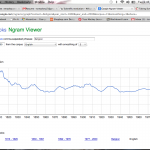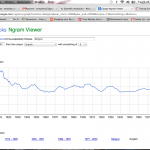I worked with the Ngram tool this weekend to see how it worked, but after our discussion on Monday, I understand more how this data is construed. I found the word ‘religion’ to be particularly interesting when it was matched with the word ‘science’ because of the change from a very spiritual and theological society to the age of science and the revolution that proceeded it. Because the shift happened over time, and with that shift many felt that their beliefs were being challenged by philosophers, I wanted to see the spikes in which these words were mentioned in literature and if it coincided with the majority of beliefs during a specific time period.
From 1800 to the early 1900’s religion was mentioned a significant amount of times peaking at about 1828. When I clicked on the on the actual books that were written during that period, most centered around Christianity, which is no surprise. Then, when I capitalized the “R” is religion, the the peak was at about 1810, and was steady throughout the next two hundred years.
I then searched the word “science” and “Science” to see the difference in mentions. “Science” spiked after the 1930’s where as “science” was consistently mentioned throughout the whole graph.
I never really thought about the difference of structure of words or how meanings have changed to this degree before this project. I think it is beneficial to be more aware of how words are used in certain publications and historical databases. I think this will help me a lot during my project because I am researching historical documents, pictures, graphs, etc. dealing with fashion, I will have to pay more attention to the old context surrounding the word compared to the present use and the words that accompany it.


